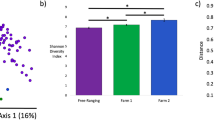Abstract
In a continuing effort to better understand the transmission and persistence of chronic wasting disease in wild populations of cervids, Colorado State University, Fort Collins houses two species of deer indoors to study the pathogenesis of chronic wasting disease. Here we report key aspects regarding the husbandry and medication of Reeves' muntjac and white-tailed deer in captivity for research purposes.
This is a preview of subscription content, access via your institution
Access options
Subscribe to this journal
We are sorry, but there is no personal subscription option available for your country.
Buy this article
- Purchase on Springer Link
- Instant access to full article PDF
Prices may be subject to local taxes which are calculated during checkout
Similar content being viewed by others
References
Miller, M.V. et al. Epizootiology of chronic wasting disease in free-ranging cervids in Colorado and Wyoming. J. Wildl. Dis. 36, 676–690 (2000).
Mathiason, C.K. et al. Infectious prions in pre-clinical deer and transmission of chronic wasting disease solely by environmental exposure. PLoS One 4, e5916 (2009).
Zanetti Edos, S., Polegato, B.F. & Duarte, J.M. Comparison of two methods of synchronization of estrus in brown brocket deer (Mazama gouazoubira). Anim. Reprod. Sci. 117, 266–274 (2010).
Walton, K.D., McNulty, E., Nalls, A.V. & Mathiason, C.K. Transabdominal ultrasound for pregnancy diagnosis in Reeves′ muntjac deer. J. Vis. Exp. 83, e50855 (2014).
Chapman, N.G. Reproductive performance of captive Reeve's muntjac. in Deer of China: Biology and Management (eds. Otaishi, N. & Sheng, H.) 199 (Elsevier, Philadelphia, PA, 1993).
Ahmed, A.F., Constable, P.D. & Misk, N.A. Effect of orally administered omeprazole on abomasal luminal pH in dairy calves fed milk replacer. J. Vet. Med. A Physiol. Pathol. Clin. Med. 52, 238–243 (2005).
Kreeger, T.J. & Arnemo, J.M. Handbook of Wildlife Chemical Immobilization 4th edn. (International Wildlife Veterinary Services, Incorporated, Fort Collins, CO, 2012).
Dutton, C.J., Duncan, M. & Price, H.I. Hydromyelia in a Reeves' muntjac (Muntiacus reevesi). J. Zoo Wildl. Med. 33, 256–262 (2002).
Mich, P.M. et al. Evaluation of intramuscular butorphanol, azaperone, medetomidine and nasal oxygen insufflation for the chemical immobilization of white-tailed deer, Odocoileus virginianus. J. Zoo Wildl. Med. 39, 480–487 (2008).
Miller, B.F. et al. Butorphanol-azaperone-medetomidine for immobilization of captive white-tailed deer. J. Wildl. Dis. 45, 457–467 (2009).
Author information
Authors and Affiliations
Corresponding author
Ethics declarations
Competing interests
The authors declare no competing financial interests.
Rights and permissions
About this article
Cite this article
McNulty, E., Selariu, A., Anderson, K. et al. Aspects of the husbandry and management of captive cervids. Lab Anim 45, 140–142 (2016). https://doi.org/10.1038/laban.972
Received:
Accepted:
Published:
Issue Date:
DOI: https://doi.org/10.1038/laban.972



